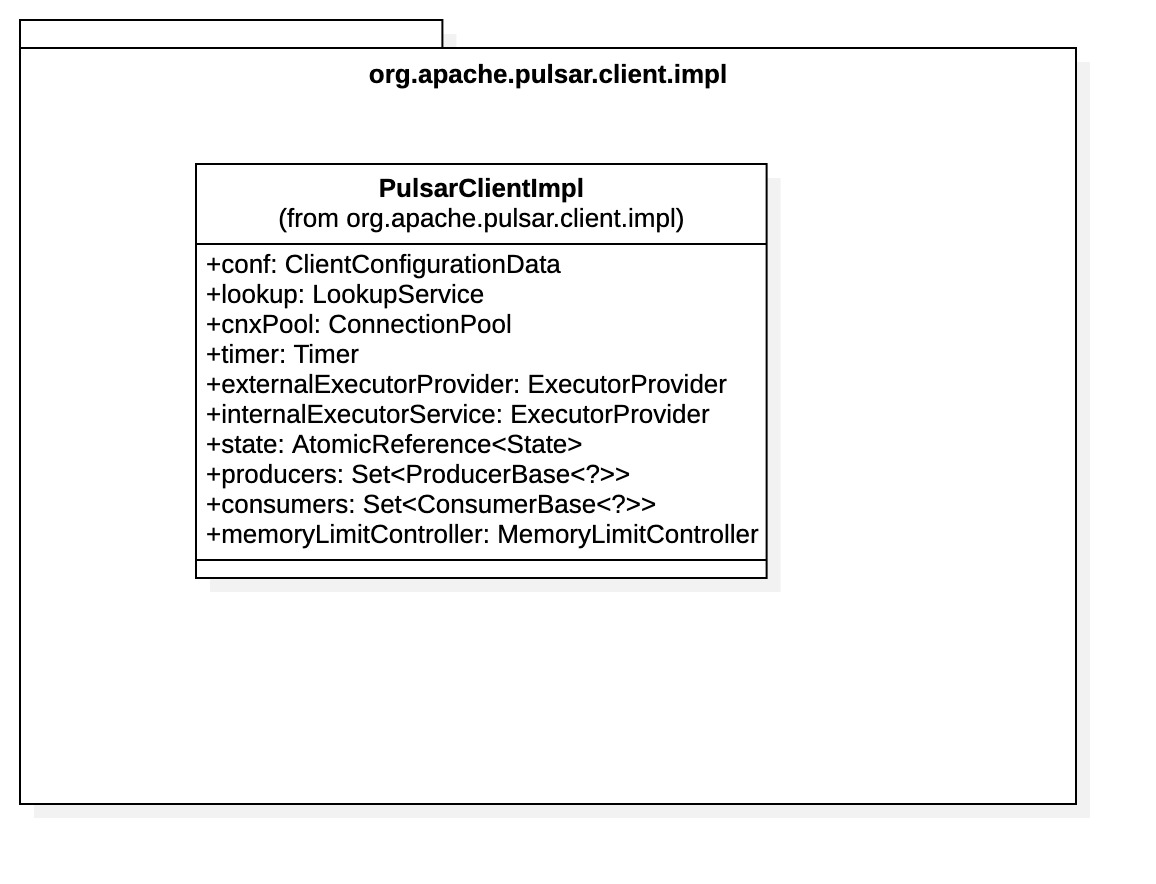(1). 概述
在前面剖析了,我们通过ClientBuilder可以build出一个:PulsarClient,在这里,主要剖析:PulsarClient的构造函数初始化过程.
(2). PulsarClientImpl构造器
public PulsarClientImpl(ClientConfigurationData conf) throws PulsarClientException {
this(conf, getEventLoopGroup(conf), true);
}// end PulsarClientImpl
// 通过配置(numIoThreads/enableBusyWait),创建:io.netty.channel.EventLoopGroup
private static EventLoopGroup getEventLoopGroup(ClientConfigurationData conf) {
ThreadFactory threadFactory = getThreadFactory("pulsar-client-io");
return EventLoopUtil.newEventLoopGroup(conf.getNumIoThreads(), conf.isEnableBusyWait(), threadFactory);
}// end getEventLoopGroup
(3). PulsarClientImpl构造器
private PulsarClientImpl(ClientConfigurationData conf, EventLoopGroup eventLoopGroup, boolean createdEventLoopGroup) throws PulsarClientException {
// **********************************************************************************
// ConnectionPool实际上是:创建Netty Client,ConnectionPool的内容,另开一篇来剖析,暂时就按照类的命名来理解:连接池即可.
// **********************************************************************************
this(conf, eventLoopGroup, new ConnectionPool(conf, eventLoopGroup), null, createdEventLoopGroup, true);
} // end PulsarClientImpl
(4). PulsarClientImpl构造器
private PulsarClientImpl(ClientConfigurationData conf, EventLoopGroup eventLoopGroup, ConnectionPool cnxPool, Timer timer, boolean createdEventLoopGroup, boolean createdCnxPool) throws PulsarClientException {
try {
this.createdEventLoopGroup = createdEventLoopGroup;
this.createdCnxPool = createdCnxPool;
// 验证serviceUrl
if (conf == null || isBlank(conf.getServiceUrl()) || eventLoopGroup == null) {
throw new PulsarClientException.InvalidConfigurationException("Invalid client configuration");
}
this.eventLoopGroup = eventLoopGroup;
// 配置认证信息
setAuth(conf);
this.conf = conf;
clientClock = conf.getClock();
// ****************************************************************************
// 认证启用,另开一篇去剖析
// ****************************************************************************
conf.getAuthentication().start();
this.cnxPool = cnxPool;
// 这里理解成两个线程池即可
externalExecutorProvider = new ExecutorProvider(conf.getNumListenerThreads(), "pulsar-external-listener");
internalExecutorService = new ExecutorProvider(conf.getNumIoThreads(), "pulsar-client-internal");
// 策略模式
if (conf.getServiceUrl().startsWith("http")) {
lookup = new HttpLookupService(conf, eventLoopGroup);
} else {
lookup = new BinaryProtoLookupService(this, conf.getServiceUrl(), conf.getListenerName(), conf.isUseTls(), externalExecutorProvider.getExecutor());
}
// 这里用到了Netty的时间轮算法.
if (timer == null) {
this.timer = new HashedWheelTimer(getThreadFactory("pulsar-timer"), 1, TimeUnit.MILLISECONDS);
needStopTimer = true;
} else {
this.timer = timer;
}
producers = Collections.newSetFromMap(new ConcurrentHashMap<>());
consumers = Collections.newSetFromMap(new ConcurrentHashMap<>());
// 事务协调客户端初始化
if (conf.isEnableTransaction()) {
tcClient = new TransactionCoordinatorClientImpl(this);
try {
tcClient.start();
} catch (Throwable e) {
log.error("Start transactionCoordinatorClient error.", e);
throw new PulsarClientException(e);
}
}
// 限流管理
memoryLimitController = new MemoryLimitController(conf.getMemoryLimitBytes());
// 状态模式
// 状态配置为打开
state.set(State.Open);
} catch (Throwable t) {
shutdown();
shutdownEventLoopGroup(eventLoopGroup);
closeCnxPool(cnxPool);
throw t;
}
} // end PulsarClientImpl
private void setAuth(ClientConfigurationData conf) throws PulsarClientException {
// 认证插件或者认证参数为空的情况下,不对Auth进行配置.
if (StringUtils.isBlank(conf.getAuthPluginClassName()) || (StringUtils.isBlank(conf.getAuthParams()) && conf.getAuthParamMap() == null)) {
return;
}
// 通过:AuthenticationFactory创建:Authentication对象,在这里有可能是认证参数,也有可能是认证参数Map
// 典型的策略模式哈.
if (StringUtils.isNotBlank(conf.getAuthParams())) {
conf.setAuthentication(AuthenticationFactory.create(conf.getAuthPluginClassName(), conf.getAuthParams()));
} else if (conf.getAuthParamMap() != null) {
conf.setAuthentication(AuthenticationFactory.create(conf.getAuthPluginClassName(), conf.getAuthParamMap()));
}
} // end setAuth
(5). 设计模式
PulsarClient构造器,代码比较少,但是,看到了几个设计模式:
- 工厂模式(ThreadFactory/AuthenticationFactory)
- 策略模式(LookupService)
- 状态模式(State)
(6). PulsarClient类图

(7). 总结
PulsarClient构建器的过程如下:
- 通过ConnectionPool对Netty Client进行包装,目的是不用重复创建连接,而是共享连接.
- 如果有配置Auth信息,则通过工厂(AuthenticationFactory),创建:Authentication.
- 根据serviceUrl创建不同的的LookupService实现.
- 创建定时任务管理器,前面在剖析JRAFT时有专门开一篇来讲,在这里,我不剖析了的.
- PulsarClient内部会Hold住ProducerBase和ConsumerBase,它们都是集合类型.
- 如果开启了事务,创建:TransactionCoordinatorClient.
- 创建MemoryLimitController来管理限流.
